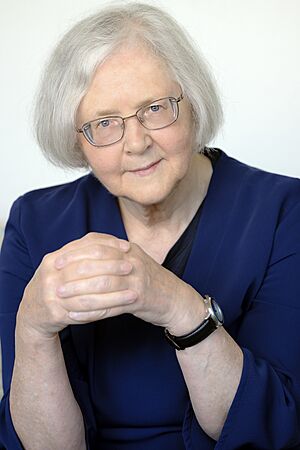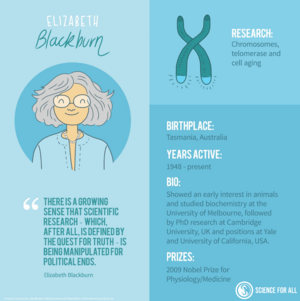Elizabeth Blackburn facts for kids
Quick facts for kids
Elizabeth Blackburn
|
|
|---|---|

Elizabeth Blackburn in 2024
|
|
| Born |
Elizabeth Helen Blackburn
26 November 1948 |
| Citizenship | Australian and American |
| Education |
|
| Awards |
|
| Scientific career | |
| Fields | Molecular biology |
| Institutions | |
| Thesis | Sequence studies on bacteriophage ØX174 DNA by transcription (1974) |
| Doctoral advisor | Frederick Sanger |
| Doctoral students | Carol W. Greider |
Elizabeth Helen Blackburn, born on November 26, 1948, is a brilliant scientist from Australia and America. She is famous for her amazing discovery of something called telomerase in 1984. Telomerase is a special enzyme that helps protect the ends of our chromosomes, called telomeres. Think of telomeres like the plastic tips on shoelaces that stop them from fraying!
For this groundbreaking work, she won the prestigious Nobel Prize in Physiology or Medicine in 2009. She shared it with her colleagues Carol W. Greider and Jack W. Szostak. She was the first Australian woman to ever win a Nobel Prize! Dr. Blackburn also shared her scientific knowledge on important topics like medical ethics.
Contents
Elizabeth Blackburn's Early Life and School Days
Elizabeth Helen Blackburn was born in Hobart, Tasmania, Australia, on November 26, 1948. She was one of seven children. Both of her parents were doctors, which might have sparked her interest in science!
When Elizabeth was four, her family moved to Launceston. She went to school there until she was sixteen. Later, her family moved to Melbourne. She attended University High School and did very well in her final exams.
Elizabeth then went to the University of Melbourne. She earned her first science degree in 1970 and a master's degree in biochemistry in 1972. She continued her studies at the University of Cambridge in England, where she earned her PhD in 1975. There, she worked with a famous scientist named Frederick Sanger. She helped develop ways to study DNA.
Discovering Telomeres and Telomerase
After her PhD, Dr. Blackburn worked at Yale University. She studied a tiny organism called Tetrahymena thermophila. She noticed something interesting about its chromosomes. The ends of these chromosomes had repeating DNA sequences.
She realized these special ends, called telomeres, were like protective caps. They stop chromosomes from getting damaged. Imagine the plastic tips on your shoelaces; telomeres do a similar job for our genetic material!
How Telomeres Protect Our Cells
Dr. Blackburn and her colleague, Jack W. Szostak, discovered that these telomeres were essential. They showed that without them, chromosomes would become unstable. This would make it hard for cells to divide properly.
They also wondered how these telomeres stayed long and healthy. Chromosomes naturally shorten a little bit each time a cell divides. If telomeres kept getting shorter, our cells would eventually stop working.
The Big Discovery: Telomerase
In 1984, Dr. Blackburn and her student, Carol W. Greider, made a huge breakthrough. They found a special enzyme that could rebuild telomeres! They named this enzyme telomerase.
Telomerase acts like a repair crew for telomeres. It adds new DNA segments to the ends of chromosomes. This keeps the telomeres long and protects our genetic information. This discovery was a major step in understanding how our bodies work. It helped explain how cells can keep dividing and stay healthy.
A Moment of Discovery
Dr. Blackburn once described the exciting moment they found telomerase. Carol Greider had run an experiment. They looked at the results, which showed a clear pattern. Dr. Blackburn remembers thinking, "Ah! This could be very big." It was a moment of pure scientific excitement!
She then joined the University of California, Berkeley. Later, she moved to the University of California, San Francisco (UCSF). She even led the Department of Microbiology and Immunology there for several years.
Winning the Nobel Prize
In 2009, Elizabeth Blackburn, Carol Greider, and Jack Szostak received the Nobel Prize in Physiology or Medicine. This was for their incredible discoveries about telomeres and telomerase. Their work changed how we understand cells and aging.
Their research showed that telomerase helps cells keep dividing. Without it, cells would age faster and stop working. This discovery has opened new doors for understanding many health issues. Scientists are still studying how telomeres and telomerase affect our health.
Sharing Scientific Advice
Dr. Blackburn also used her scientific knowledge to help guide important decisions. In 2002, she became part of a group called the President's Council on Bioethics. This council advises leaders on ethical questions related to science and medicine.
She believed in the importance of certain types of scientific research. However, her views were different from some government policies at the time. In 2004, her time on the council ended. Many scientists felt it was important for scientific advice to be heard without political interference. They supported Dr. Blackburn, emphasizing the need for open scientific discussion.
Telomeres, Stress, and Healthy Living
Dr. Blackburn and her team have also explored how our daily lives affect telomeres. They found that things like stress can impact how well telomeres are maintained. This research suggests that long-term stress might make our cells age faster.
She has also appeared in science documentaries, sharing her knowledge with a wider audience. These films help explain complex science in an easy-to-understand way.
At the University of California, San Francisco, Dr. Blackburn continues her research. Her lab studies how telomeres and telomerase work in different living things. They want to understand how keeping telomeres healthy can help prevent diseases and slow down cellular aging.
A Book on Living Healthier
In 2017, Dr. Blackburn co-wrote a book called The Telomere Effect. It shares how our lifestyle choices can affect our telomeres and overall health. She explains that managing stress, exercising, eating well, and getting enough sleep are all important.
The book teaches us that telomeres shorten each time our cells divide. If they get too short, cells can't divide anymore. This is linked to how our bodies age. Dr. Blackburn's research shows that people with a lot of stress might have less telomerase activity. This means their telomeres might shorten faster.
She suggests that even a little bit of exercise each day can help boost telomerase. This helps keep telomeres healthy. She also emphasizes the importance of positive relationships and happiness. These factors can also contribute to longer, healthier telomeres. Dr. Blackburn advises against quick-fix pills or creams. She says that a healthy lifestyle is the real secret to protecting our telomeres.
Elizabeth Blackburn's Personal Life
While working in Cambridge, Dr. Blackburn met her husband, John Sedat. They later moved to New Haven and got married. She lives with her husband in La Jolla and San Francisco. They have a son, who was born in 1986. Dr. Blackburn is also a mentor, helping guide other scientists. She supports scientific research and policies that help science grow.
Awards and Recognitions
Dr. Elizabeth Blackburn has received many important awards and honors for her scientific work, including:
- Eli Lilly Research Award for Microbiology and Immunology (1988)
- United States National Academy of Sciences Award in Molecular Biology (1990)
- Harvey Society Lecturer at the Harvey Society in New York (1990)
- Honorary Doctorate of Science from Yale University (1991)
- Fellow of American Academy of Arts and Sciences (1991)
- Elected a Fellow of the Royal Society (FRS) in 1992
- Fellow of American Academy of Microbiology (1993)
- Foreign Associate of National Academy of Sciences (1993)
- Australia Prize (1998)
- Gairdner Foundation International Award (1998)
- Harvey Prize (1999)
- Keio Medical Science Prize (1999)
- Passano Award (1999)
- California Scientist of the Year in 1999
- American Academy of Achievement's Golden Plate Award (2000)
- American Association for Cancer Research – G.H.A. Clowes Memorial Award (2000)
- American Cancer Society Medal of Honor (2000)
- Fellow of American Association for the Advancement of Science (2000)
- AACR-Pezcoller Foundation International Award for Cancer Research (2001)
- General Motors Cancer Research Foundation Alfred P. Sloan Award (2001)
- E.B.Wilson Award of the American Society for Cell Biology (2001)
- Bristol-Myers Squibb Award (2003)
- Robert J. and Claire Pasarow Foundation Medical Research Award (2003)
- Dr A.H. Heineken Prize for Medicine (2004)
- Benjamin Franklin Medal in Life Science of The Franklin Institute (2005)
- Albert Lasker Award for Basic Medical Research (2006) (shared with Carol W. Greider and Jack Szostak)
- Genetics Prize from the Peter Gruber Foundation (2006)
- Honorary Doctorate of Science from Harvard University (2006)
- Wiley Prize in Biomedical Sciences from the Wiley Foundation (shared with Carol W. Greider) (2006)
- Fellow of Australian Academy of Science (2007)
- Corresponding fellow of the Australian Academy of Science (2007)
- Recipient of the UCSF Women's Faculty Association Award
- Honorary Doctorate of Science from Princeton University (2007)
- Louisa Gross Horwitz Prize of Columbia University (2007) (shared with Carol W. Greider and Joseph G. Gall)
- L'Oréal-UNESCO Award for Women in Science (2008)
- Albany Medical Center Prize (2008)
- Pearl Meister Greengard Prize (2008)
- Tasmanian Honour Roll of Women (2008)
- Victorian Honour Roll of Women (2010)
- Mike Hogg Award (2009)
- Paul Ehrlich and Ludwig Darmstaedter Prize (2009) (shared with Carol W. Greider)
- The Nobel Prize in Physiology or Medicine 2009, shared with Carol W. Greider and Jack W. Szostak "for the discovery of how chromosomes are protected by telomeres and the enzyme telomerase"
- Companion of the Order of Australia (Australia Day Honours, 2010), for "eminent service to science as a leader in the field of biomedical research, particularly through the discovery of telomerase and its role in the development of cancer and ageing of cells and through contributions as an international adviser in Bioethics."
- Fellow of the Royal Society of New South Wales (FRSN) (2010)
- California Hall of Fame (2011)
- AIC Gold Medal (2012)
- The Royal Medal of the Royal Society (2015).
- Honorary Fellow at Jesus College, Oxford
Blackburn was also elected to lead several important scientific organizations:
- President of the Salk Institute for Biological Studies (2016–2017)
- President of the American Association for Cancer Research for 2010
- President of the American Society for Cell Biology for 1998
- Foreign associate of the National Academy of Sciences (1993)
- Member of the Institute of Medicine (2000)
- Board member of the Genetics Society of America (2000–2002)
- Member of the American Philosophical Society (2006)
In 2007, Dr. Blackburn was recognized by Time magazine as one of the 100 people who shape our world.
See also
 In Spanish: Elizabeth Blackburn para niños
In Spanish: Elizabeth Blackburn para niños



